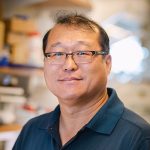
Jung-Mo Ahn
Associate Professor, University of Texas at Dallas
Structure-Based Design of Alpha-Helix Mimetics for Inhibiting Protein-Protein Interactions and Treating Breast Cancer
Abstract
We have designed an oligo-benzamide scaffold as a rigid template to replicate protein helices. It presents side chains of the amino acid residues found at the i, i+4, and i+7 positions in a helix in addition to two substituents at its N- and C-termini for achieving higher affinity, selectivity, and improved physicochemical properties. It has demonstrated outstanding mimicry of LXXLL motifs that is critical to facilitate protein-protein interactions between nuclear receptors and their coactivators. Bis-benzamide D2 was found to disrupt androgen receptor and its coactivators effectively in prostate cancer models, whereas tris-benzamide ERX-11 showed potent inhibition of estrogen receptor in breast cancer models. Recently, our efforts to further improve these leads identified a new therapeutic target, lyososomal acid lipase A (LIPA) for treating hard-to-kill cancers like triple-negative breast cancer. Tris-benzamide-based ERX-41 was found to induce endoplasmic reticulum (ER) stress, resulting in cell death. Mechanistically, ERX-41 binding to LIPA decreases expression of multiple ER-resident proteins involved in protein folding. This targeted vulnerability has a large therapeutic window with no adverse effects either on normal mammary epithelial cells or in mice. It is also found to be metabolically stable and orally available.
Bio
Jung-Mo Ahn is an Associate Professor in the Department of Chemistry and Biochemistry at the University of Texas at Dallas. He completed postdoctoral research at the Scripps Research Institute after he earned his PhD from the University of Arizona. His research primarily focuses on the development of small molecules to modulate protein function. In particular, he has designed rigid organic scaffold that mimic protein helical surfaces, aiming to disrupt protein-protein interactions. This novel class of molecules has demonstrated an outstanding potential in inhibiting nuclear receptors including androgen and estrogen receptors from interacting with their coactivator proteins. They showed remarkable in vivo efficacy in inhibiting the growth of prostate and breast cancer cells. He has authored over 100 peer-reviewed publications and holds multiple patents.
